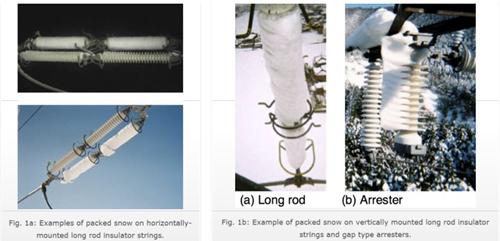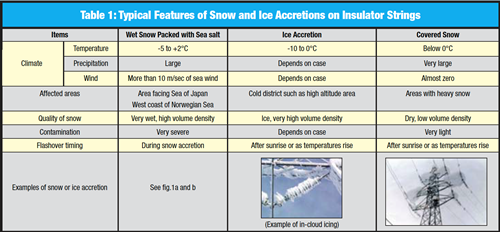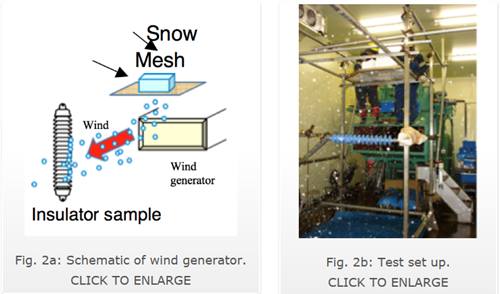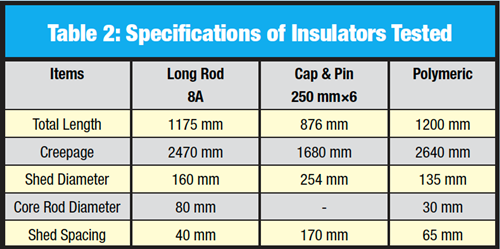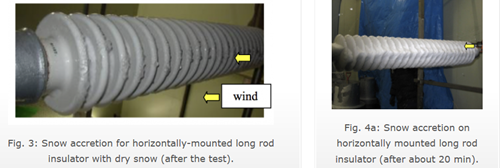Figure 3 shows a horizontally mounted long rod porcelain insulator after the test. Although a small number of snow particles were attached to its surface, these never grew into a large-scale accretion. This finding agrees with service experience that indicates outages caused by snow packed with sea salt are induced only by wet snow.
The process of snow accretion on conductors is already quite well known and is the result of two different combined mechanisms: one sees the snow accreted onto the conductor surface sliding slowly along the strands from its weight; the other sees the conductor itself rotate due to the weight of accreted snow. In the case of insulators, the process is basically the same although, since insulator strings are fixed to towers, the latter mechanism clearly does not apply.
In the case of the wet snowstorm in the Niigata area, the cylinder-like shape of packed snow was observed on both horizontally and vertically mounted long rod insulators. The shape of packed snow in this test, however, was developed on only the windward side of the insulator and therefore did not exactly reproduce the shape of packed snow observed in the field. On the other hand, the eccentric pennant shape of packed snow into the wind direction was also found on a polymeric gap type arrester during the Niigata storm. The differences in formation conditions and processes between the cylindrical shape and the eccentric pennant into the wind is not yet clear and will be left for future research.
Three important points were confirmed during this test.
1. The time for vertically mounted insulators to be bridged between the sheds was shorter than for horizontally mounted ones. In the vertical arrangement, the upper parts of sheds are quickly covered with snow and the sheds are easily bridged. This suggests that I-strings may be more prone to failure than either tension or dead-end strings. At the same time, many traces of power arcs were also found on horizontal insulator strings during the wet snowstorm. In this respect, field experience does not agree with test results and electrical failures may be related not only to wet snow accretion but also to various flashover mechanisms that still need to be clarified.
2. Movement of water to the bottom of packed snow was seen in this case (see Fig. 7 and 8) and could be related to the subsequent flashover mechanism.
3. Once snow does bridge sheds, the packed snow cannot easily be removed from the insulator surface whereas before bridging the snow tends to be blown away by wind. Nevertheless, snow accretion progresses quite slowly along the insulator’s axial direction and this effect can be explained by the fact that the adhesive tensile strength of snowflakes is greater than their adhesive shear strength. Long rod insulators are not only more easily bridged by snow but the accreted snow is at the same time not easily removed by wind-induced vibrations in the field.
A test with wet snow (LWC 5% and volume density 0.3 g/cm
3) was also carried out for a horizontally mounted cap & pin insulator. In this case, the snow accreted on the cap parts first but tended to be easily removed by its weight so that it never grew to bridge the sheds. Figs. 9 a & b show the snow accretion after the test. Since a cap & pin type insulator has a relatively larger shed diameter and spacing, snow accretion cannot easily grow to bridge sheds and tends to be removed by its weight.
A vertically mounted cap & pin insulator string was also tested (LWC 7% and volume density 0.4 g/cm3). At first, the snow accreted on the upper parts of the sheds and finally bridged the sheds in a packed condition. Fig. 10a shows the snow accretion just before bridging while Fig. 10b shows the comparison between the cap & pin and the porcelain long rod insulator tested at the same time. The time needed to bridge the cap & pin type was about 50 minutes but only about 10 min for the long rod.
Finally, tests were performed involving wet snow (LWC 7 % and volume density 0.3 g/cm3) on a horizontally mounted polymeric insulator over a duration of 30 minutes. The snow accreted on the core rod first and then gradually became packed, followed by bridging between the sheds. Figs. 11a & b show the snow accretion after the test. The shape of packed snow was like eccentric pennants into the wind. However, the snow tended to be easily blown off by wind in comparison with the porcelain long rod insulator. This might the result of a smaller core rod for the polymer in comparison with the long rod insulator – which results in a smaller area of contact between the surface and snow particles. As a result, in the case of polymeric insulators the shape of accreted snow was not cylinder-like but rather eccentric perpendicular into the wind.
The same test with wet snow (LWC 4 % and volume density 0.3g/cm
3) was then carried out for a vertically mounted polymeric insulator for 50 min. A porcelain long rod insulator was also set in parallel for comparison. At first, the snow accreted on the upper part of the sheds, (Fig. 12a) and finally bridged and packed between the sheds.
The time needed to bridge the polymeric insulator was about 20-30 min. versus about 10 min. for the porcelain long rod. Since shed spacing for the polymeric type is larger than for the porcelain long rod, the time to bridge it is about two to three times longer.
During the test, the polymeric insulator maintained high hydrophobicity (Fig. 13), but this property seemed to have little effect on snow accretion. In this regard it can be concluded that shed profile appears to be more important than shed material.
Conclusions
1. Electrical failures of insulators by wet snow packed with sea-salt can be induced by unusual climatic conditions involving a great deal of wet snow with high conductivity combined with heavy winds. This phenomenon is quite distinct from the more commonly observed ice accretion or covered snow on insulator strings.
2. In order to clarify the failure mechanisms and establish effective countermeasures, the basic properties of the packed snow need to be better understood. To this end, artificial snow accretion tests have been performed on a qualitative basis as a first step toward future quantitative studies.
3. In these tests, several basic properties of packed wet snow were demonstrated and issues for future research identified, including:
a) The packed snow was reproduced on insulators using wet snow (LWC of 5-8%) whereas no snow accretion was seen using dry snow (LWC of 0%). This corresponds well with service experience that indicates that such outages are caused by packed, wet snow laden with contamination such as sea salt.
b) The cylinder-like shape of packed snow occurring in Niigata and triggering the widespread blackout of 2005 was reproduced on horizontally mounted long rod insulators and the mechanism of such a snow pack process was demonstrated. This mechanism – whereby snow grows by rotating along the insulator surface to become cylindrical – is basically the same as with snow accretion on conductors.
c) The shape of packed snow on vertically mounted long rod insulators in this test was eccentric pennant into the wind. While this shape shows some similarity with the packed snow on the polymeric arresters in Niigata, the cylinder like shape seen on many long rods was not reproduced. Test methodology or conditions may therefore have to be improved for any future research.
d) Shed profile affects the properties of wet snow accretion. Wider shed diameter and larger shed spacing results in lesser amounts of snow accretion and reduced possibility of bridging sheds. Therefore, cap & pin insulators perform the best and polymeric insulators are the next choice. Porcelain long rod insulators are the most vulnerable to packed snow. Bridging of the sheds can more easily occur on vertical than on horizontally mounted long rod insulators. This suggests that V-strings are most vulnerable and I-strings also become vulnerable as they sway due to winds.
e) The hydrophobicity of polymeric insulators seems to play little role in snow accretion. Shed profile is more important than shed material.
f) Once snow bridges the sheds and becomes packed, it cannot easily be removed from the insulator surface. The adhesion tensile strength between the snow particles and between the insulator surface and snow particles is strong.
g) Water inside the packed wet snow tends to move downward and accumulate near the bottom of the insulator, making the LWC at the bottom larger than on other sections or even that of the original snow. While clarifying the flashover mechanism will be left for the future research, water migration may play an important role in this process.
Based on all these findings and the areas identified as requiring further research, another artificial wet snow accretion test having an improved test methodology is planned for the near future.

